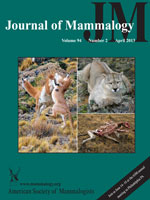Plasticity of circadian rhythm was investigated for the model species desert hamster (Phodopus roborovskii) under natural conditions in the Alashan Desert using the radiofrequency identification (RFID) technique, that is, animals were caught in the field and marked with passive transponders, and burrows were equipped with integrated microchip readers and photosensors for detection of movements into or out of the burrow. Additionally, video observations with infrared cameras were conducted at feeding sites to verify RFID data and analyze interspecific behavior. Composition of the rodent community changed during observation periods from a midday gerbil (Meriones meridianus)-dominated community to a desert hamster (P. roborovskii)-dominated community in 2009 and from a northern three-toed jerboa (Dipus sagitta)-dominated community to a hamster-dominated community in 2010. Activity pattern of hamsters was clearly affected by species composition. In the hamster-dominated community, activity started 1.7 h ± 1.0 SD after sundown and ended 7.2 ± 1.4 h after sundown. A similar activity pattern was found for the jerboa-dominated community. In contrast, hamsters shortened their activity tremendously in the gerbil-dominated community, to 2.2 ± 1.3 h (activity began at 0.8 ± 0.3 h after sundown and ended at 3.0 ± 1.5 h after sundown). An analysis of interspecific behavior at feeding sites showed clearly that gerbil behavior was characterized by aggressive attacks (60.4% attacks versus 6.1% being attacked), whereas jerboa behavior was dominated by avoidance of direct contact (67.5% avoidance versus 22.9% attack). Hamster intraspecific behavior included all 4 elements in a similar ratio (27.3% attacks, 21.8% being attacked, 22.7% fleeing without direct contact, and 22.7% causing fleeing without direct contact).
How to translate text using browser tools
1 April 2013
Species composition and interspecific behavior affects activity pattern of free-living desert hamsters in the Alashan Desert
Elke Scheibler,
Franziska Wollnik,
David Brodbeck,
Elisabeth Hummel,
Shuai Yuan,
Fu-Shun Zhang,
Xiao-Dong Zhang,
He-Ping Fu,
Xiao-Dong Wu
ACCESS THE FULL ARTICLE

Journal of Mammalogy
Vol. 94 • No. 2
April 2013
Vol. 94 • No. 2
April 2013
activity pattern
heterospecific competition
Phodopus roborovskii
temporal niche plasticity




